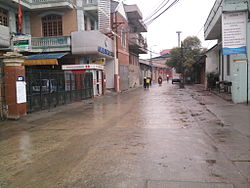Gia Lâm district
Quận Gia Lâm | |
|---|---|
 Street of Bat Trang commune, Gia Lam district, Hanoi on the morning of the Lunar New Year (2012). | |
| Coordinates: 21°01′10″N 105°56′16″E / 21.019520°N 105.937664°E | |
| Country | |
| Region | Red River Delta |
| Municipality | Hanoi |
| Capital | Trâu Quỳ |
| Time zone | UTC+7 (Indochina Time) |
Gia Lâm is the easternmost urban district (quận) of Hanoi, the capital city of Vietnam. Prior to 2003, the district covered the entire area of Long Biên district, which included Long Biên Bridge, Gia Lâm Airport, Gia Lâm railway station, Gia Lâm bus station and the headquarters of Vietnam Airlines. On 22 September 2023, the Hanoi People Committee approved Gia Lam to become the next urban district of Hanoi.
Geography
[edit]Gia Lâm district is bordered by Bắc Ninh province to the east and north, Đông Anh district to the northwest, Long Biên district and Hoàng Mai district to the west, Thanh Trì district and Hưng Yên province to the south.
As of 2011, the district had a population of 243,957. The district covers an area of 115 km2 (44 sq mi). The district capital lies at Trâu Quỳ township.[1]
Gia Lâm district is subdivided to 22 commune-level subdivisions, including the townships of Trâu Quỳ (district capital), Yên Viên and the rural communes of: Bát Tràng, Cổ Bi, Đa Tốn, Đặng Xá, Đình Xuyên, Đông Dư, Dương Hà, Dương Quang, Dương Xá, Kiêu Kỵ, Kim Lan, Kim Sơn, Lệ Chi, Ninh Hiệp, Phù Đổng, Phú Thị, Trung Mầu, Văn Đức, Yên Thường, Yên Viên.
References
[edit]- ^ "About Gia Lâm District (in Vietnamese)". Archived from the original on May 14, 2017. Retrieved March 9, 2017.



Well, that’s interesting to know that Psilotum nudum are known as whisk ferns. Psilotum nudum is the commoner species of the two. While the P. flaccidum is a rare species and is found in the tropical islands. Both the species are usually epiphytic in habit and grow upon tree ferns. These species may also be terrestrial and grow in humus or in the crevices of the rocks.
View the detailed Guide of Psilotum nudum: Detailed Study Of Psilotum Nudum (Whisk Fern), Classification, Anatomy, Reproduction